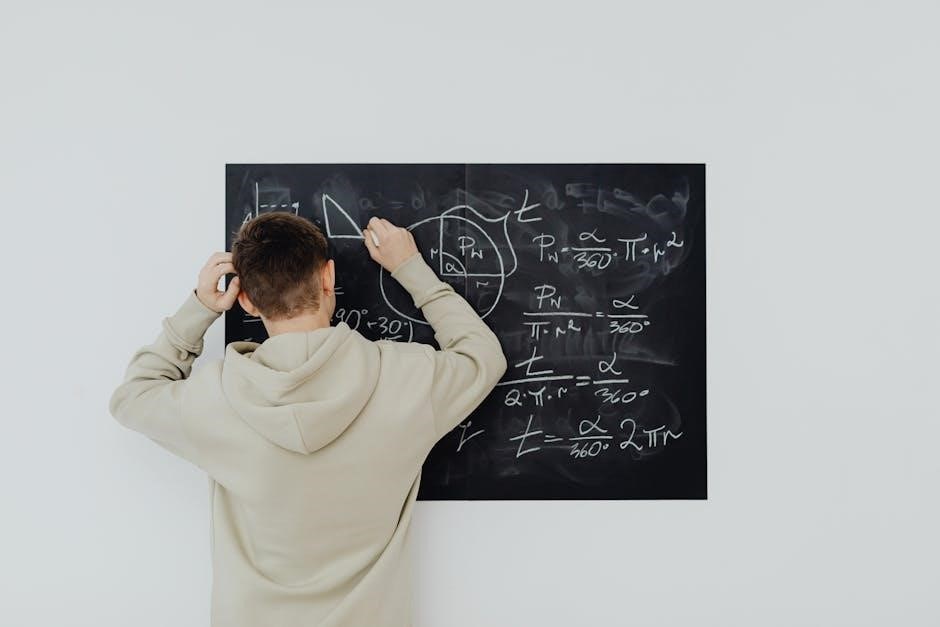AP Physics C: E&M Study Guide
This guide helps you navigate the AP Physics C: Electricity and Magnetism exam. It covers core concepts, formulas, and essential information. Remember, a strong calculus foundation is crucial. Use this guide alongside resources and practice problems for success. Good luck with your AP exam preparation!
Overview of AP Physics C: E&M
AP Physics C: Electricity and Magnetism (E&M) is a calculus-based, college-level physics course. It’s designed for students with a solid foundation in physics and mathematics, particularly calculus. This course delves into the fundamental principles governing electric and magnetic phenomena, exploring concepts like electrostatics, circuits, magnetic fields, and electromagnetic induction.

The AP Physics C: E&M curriculum overlaps partially with AP Physics 2. However, while Physics 2 is algebra-based and encompasses a broader range of topics, Physics C focuses exclusively on electromagnetism, employing calculus to formulate physical principles and solve complex problems. Proficiency in calculus is essential for success in this course.
This study guide will navigate you through the key topics covered on the AP Physics C: E&M exam. It provides a structured approach to understanding challenging concepts and applying them to problem-solving. By engaging with this material and seeking additional resources, you can build a comprehensive understanding of electromagnetism and prepare effectively for the AP exam. Remember to focus on understanding the underlying principles and practicing applying calculus to solve physics problems.
Prerequisites: Calculus and Prior Physics Knowledge
Before embarking on your AP Physics C: E&M journey, ensure you possess a solid foundation in both calculus and fundamental physics principles. Calculus serves as the mathematical language of this course, enabling a deeper understanding of electromagnetic phenomena. Familiarity with derivatives, integrals, and differential equations is crucial for grasping key concepts and solving complex problems.
Prior physics knowledge, ideally from a previous physics course like AP Physics 1 or a comparable introductory course, is equally important. A grasp of mechanics concepts, such as kinematics, dynamics, energy, and momentum, will provide a valuable framework for understanding the behavior of electric and magnetic fields.
Without a strong background in these areas, the challenges of AP Physics C: E&M can be significantly amplified. Dedicate time to reviewing essential calculus and physics concepts before diving into electromagnetism. Consider working through practice problems and seeking clarification on any areas where your understanding is lacking. A strong foundation will pave the way for a more rewarding and successful learning experience in AP Physics C: E&M.
Electrostatics: Electric Charge and Coulomb’s Law
Electrostatics forms the bedrock of electromagnetism, dealing with stationary electric charges and the forces they exert. Electric charge, a fundamental property of matter, exists in two forms: positive and negative. The magnitude of charge on a single electron is the elementary charge, a fundamental constant.
Coulomb’s Law quantifies the electrostatic force between two point charges. This force is directly proportional to the product of the charges and inversely proportional to the square of the distance separating them. Mathematically, it’s expressed as F = k * |q1 * q2| / r², where F is the force, k is Coulomb’s constant, q1 and q2 are the charges, and r is the distance.
Understanding Coulomb’s Law is essential for analyzing the interactions between charged objects. Remember that the force is attractive if the charges have opposite signs and repulsive if they have the same sign. Mastering the concepts of electric charge and Coulomb’s Law is crucial before moving on to more advanced topics in electromagnetism. Practice applying Coulomb’s Law to various charge configurations to solidify your understanding.
Electric Fields
Electric fields are a fundamental concept in electromagnetism, representing the influence of electric charges on the surrounding space. An electric field exists in a region if a charged object placed in that region experiences an electric force. The electric field is a vector quantity, possessing both magnitude and direction.
The electric field strength at a point is defined as the force per unit charge that a positive test charge would experience at that point. Mathematically, it’s expressed as E = F/q, where E is the electric field, F is the electric force, and q is the test charge. Electric field lines are a visual representation of the electric field, indicating the direction of the force on a positive test charge.
Electric fields are created by electric charges. A positive charge creates an electric field that points radially outward, while a negative charge creates an electric field that points radially inward. The electric field due to multiple charges can be found by vectorially adding the individual electric fields created by each charge. Understanding electric fields is crucial for analyzing the motion of charged particles in electric fields and for understanding the behavior of capacitors and other electrical components. Remember to consider superposition when finding electric fields.
Gauss’s Law
Gauss’s Law is a powerful tool in electrostatics that provides a convenient way to calculate the electric field in situations with high symmetry. It relates the electric flux through a closed surface to the enclosed electric charge. The electric flux is a measure of the number of electric field lines passing through a surface.
Gauss’s Law states that the total electric flux through a closed surface is proportional to the enclosed electric charge divided by the permittivity of free space (ε₀). Mathematically, it’s expressed as ∮ E ⋅ dA = Qenc/ε₀, where E is the electric field, dA is an infinitesimal area vector on the closed surface, and Qenc is the enclosed charge. To effectively apply Gauss’s Law, one must choose a Gaussian surface that takes advantage of the symmetry of the charge distribution.
Common Gaussian surfaces include spheres, cylinders, and boxes. The choice of the Gaussian surface should be such that the electric field is either constant and perpendicular to the surface or parallel to the surface (resulting in zero flux). Gauss’s Law is particularly useful for calculating the electric field due to charged spheres, infinite charged lines, and infinite charged planes. Remember to carefully consider the symmetry of the problem when choosing a Gaussian surface.
Electric Potential
Electric potential, often denoted as V, is a scalar quantity representing the electric potential energy per unit charge at a specific location in an electric field. It’s analogous to gravitational potential energy in mechanics. The electric potential difference between two points is the work done per unit charge to move a charge between those points. A key concept is that electric potential is path-independent for conservative electric fields, meaning the potential difference only depends on the initial and final positions.
The electric potential is related to the electric field by V = -∫ E ⋅ dl, where the integral is taken along a path from a reference point (often infinity) to the point of interest. For a point charge q, the electric potential at a distance r is given by V = kq/r, where k is Coulomb’s constant. Understanding equipotential surfaces is crucial; these are surfaces where the electric potential is constant. Electric field lines are always perpendicular to equipotential surfaces, indicating the direction of the force on a positive charge.
Calculating electric potential for various charge distributions, such as dipoles or continuous charge distributions, often involves integration. The superposition principle applies to electric potential, meaning the total potential due to multiple charges is the algebraic sum of the potentials due to each individual charge. Mastering the relationship between electric potential, electric field, and electric potential energy is essential for solving problems in electrostatics.

Conductors, Capacitors, and Dielectrics
Conductors are materials with free charges that can move easily under the influence of an electric field. In electrostatic equilibrium, the electric field inside a conductor is zero, and any excess charge resides on its surface. The electric potential is constant throughout a conductor. Capacitors are devices designed to store electrical energy by accumulating charge on two separated conductors, called plates. The capacitance (C) is the ratio of the charge (Q) stored on the capacitor to the potential difference (V) between the plates: C = Q/V.
For a parallel-plate capacitor, the capacitance is given by C = ε₀A/d, where ε₀ is the permittivity of free space, A is the area of each plate, and d is the separation between the plates. Energy is stored in a capacitor due to the electric field between the plates, and the energy stored is given by U = (1/2)CV². Dielectrics are insulating materials that can be inserted between the plates of a capacitor to increase its capacitance. When a dielectric is inserted, the capacitance increases by a factor of the dielectric constant (κ): C’ = κC.

The presence of a dielectric reduces the electric field strength between the plates, allowing for more charge to be stored at a given voltage. Understanding how to calculate the equivalent capacitance of capacitors in series and parallel is crucial for circuit analysis. For capacitors in series, the reciprocal of the equivalent capacitance is the sum of the reciprocals of individual capacitances. For capacitors in parallel, the equivalent capacitance is the sum of the individual capacitances.
Electric Circuits
Electric circuits involve the flow of electric charge through a closed path. A circuit typically consists of a voltage source, such as a battery, and various circuit elements, such as resistors, capacitors, and inductors. The current (I) is the rate of flow of charge and is measured in amperes (A). Resistance (R) is the opposition to the flow of current and is measured in ohms (Ω). Ohm’s Law states that the voltage (V) across a resistor is proportional to the current flowing through it: V = IR.
Resistors in series have the same current flowing through them, and their equivalent resistance is the sum of the individual resistances. Resistors in parallel have the same voltage across them, and the reciprocal of their equivalent resistance is the sum of the reciprocals of the individual resistances. Kirchhoff’s Laws are fundamental principles for analyzing circuits. Kirchhoff’s Current Law (KCL) states that the sum of currents entering a junction is equal to the sum of currents leaving the junction.
Kirchhoff’s Voltage Law (KVL) states that the sum of the voltage drops around any closed loop in a circuit is zero. Power (P) is the rate at which energy is dissipated or supplied in a circuit and is given by P = IV = I²R = V²/R. Analyzing circuits with capacitors involves understanding their charging and discharging behavior. The time constant (τ) for an RC circuit is given by τ = RC, which determines the rate at which the capacitor charges or discharges.
Magnetic Fields
Magnetic fields are regions of space where magnetic forces are exerted. These fields are created by moving electric charges, such as currents in wires or intrinsic magnetic moments of elementary particles; The magnetic field is a vector quantity, possessing both magnitude and direction. Its strength is measured in Tesla (T). Magnetic fields are visualized using magnetic field lines, which indicate the direction of the field at any given point. The closer the lines, the stronger the field.
A charged particle moving in a magnetic field experiences a force. This force is perpendicular to both the velocity of the charge and the magnetic field direction. The magnitude of the magnetic force on a single charge q moving with velocity v in a magnetic field B is given by F = qvBsinθ, where θ is the angle between v and B. This force causes the particle to move in a circular or helical path.
A current-carrying wire also experiences a force in a magnetic field. The force on a straight wire of length L carrying a current I in a magnetic field B is given by F = ILBsinθ, where θ is the angle between the wire and the magnetic field. These principles are fundamental to understanding the operation of electric motors and other electromagnetic devices.
Sources of Magnetic Fields
Magnetic fields are generated by moving electric charges. One fundamental source is electric current. A current-carrying wire produces a magnetic field around it. The strength and direction of the magnetic field depend on the magnitude and direction of the current, as well as the distance from the wire. Ampere’s Law provides a mathematical relationship between the magnetic field around a closed loop and the current passing through the loop;
Another source of magnetic fields is intrinsic magnetic dipole moments of elementary particles, such as electrons. These moments are associated with the spin of the particles. Materials with aligned atomic magnetic moments exhibit macroscopic magnetism. Ferromagnetic materials, like iron, can be permanently magnetized due to the alignment of their magnetic domains. Paramagnetic materials are weakly attracted to magnetic fields, while diamagnetic materials are weakly repelled.
Solenoids and toroids are common devices used to create controlled magnetic fields. A solenoid is a coil of wire that produces a nearly uniform magnetic field inside when current passes through it. A toroid is a solenoid bent into a donut shape, which confines the magnetic field within the toroid. The magnetic field strength inside these devices can be calculated using Ampere’s Law, taking into account the geometry and the current.
Electromagnetic Induction
Electromagnetic induction is the process where a changing magnetic field induces a voltage (electromotive force or emf) in a circuit. This phenomenon is described by Faraday’s Law of Induction. The induced emf is proportional to the rate of change of magnetic flux through the circuit. Magnetic flux is a measure of the amount of magnetic field lines passing through a given area.
Lenz’s Law provides the direction of the induced current. The induced current creates a magnetic field that opposes the change in the original magnetic flux. This opposition is crucial for energy conservation. Motional emf is a specific case where a conductor moves through a magnetic field, inducing a voltage. The magnitude of the motional emf depends on the magnetic field strength, the length of the conductor, and its velocity.

Inductors are circuit elements designed to store energy in a magnetic field. They typically consist of a coil of wire. The inductance of an inductor depends on its geometry and the number of turns in the coil. When the current through an inductor changes, it induces a back emf that opposes the change in current. This property is used in various applications, such as filtering circuits and energy storage.
Exam Preparation Strategies and Resources
Electromagnetism
Electromagnetism unifies electricity and magnetism as two aspects of a single fundamental force. This force governs the interactions between charged particles. Accelerating charges produce electromagnetic waves, which propagate through space at the speed of light. These waves consist of oscillating electric and magnetic fields, perpendicular to each other and to the direction of propagation. The electromagnetic spectrum encompasses a wide range of frequencies and wavelengths, including radio waves, microwaves, infrared radiation, visible light, ultraviolet radiation, X-rays, and gamma rays.
Maxwell’s equations are a set of four fundamental equations that describe the behavior of electric and magnetic fields. These equations demonstrate how electric fields can be produced by changing magnetic fields and vice versa. They also predict the existence of electromagnetic waves and their speed of propagation. The Poynting vector describes the energy flux of electromagnetic waves, indicating the direction and rate of energy flow. Electromagnetic radiation carries energy and momentum, which can be transferred to objects it interacts with.
Applications of electromagnetism are ubiquitous in modern technology. These applications include electric motors, generators, transformers, radio communication, and medical imaging. Understanding electromagnetism is crucial for designing and analyzing these technologies. It also plays a vital role in various scientific disciplines, such as astrophysics, materials science, and particle physics. The study of electromagnetism provides insights into the fundamental nature of the universe.
